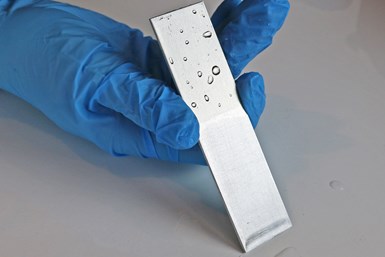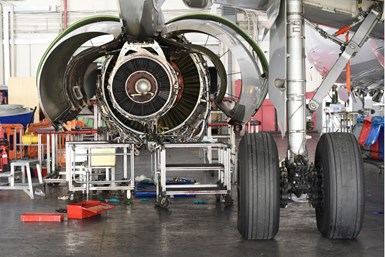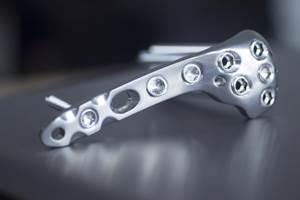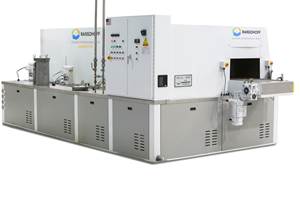4 Considerations for Aerospace Component Cleaning
These pointers for aerospace cleaning can help companies understand best practices, safety and determining part cleanliness.
This water break test on an aerospace component shows how clean the part really is. Photo Credit: Brulin
Precision cleaning in the aerospace industry is a vital step, ensuring the safety of the thousands that fly every day. Even a tiny amount of grease and particles left on aerospace parts can be disastrous.
It’s a tough job. The Boeing 737 has 600,000 total parts — the 777 has 3 million parts. All must be cleaned to exacting specifications. That’s impossible to do manually and is challenging even in an automated process. But what’s the best way to do it?
The Manufacturing Cleaning Association recently asked me to share my advice on considerations for cleaning aerospace components. Here are my replies to four questions manufacturers commonly consider.
What are basic safety tips for aerospace cleaning?
Talking about basic safety steps everyone can take might seem unnecessary, considering we’re all professionals. However, our experience has shown that sometimes even basic precautions aren’t followed.
Limit the risk to your workers by offering protective glasses, aprons, gloves and adequate ventilation in the work area. Ear protection is also a good idea: shops can be noisy places. Education is also crucial: workers should know what they’re dealing with.
Review your safety policies regularly, especially after process changes. Your safety processes will change over time.
What are the best oil removal methods?
Detergents have a maximum soil “capacity” before any soils removed start getting redeposited on the surface of the part again. Variations in the substrate of the part being cleaned can also contribute to uneven cleaning performance.
The best method varies based on the properties of the oil itself. Water-soluble oils are more difficult to separate from the cleaning solution as it dissolves into the wash tank chemistry, so monitoring is critical. Foaming (especially if the cleaning solution is sprayed) and water spots post-cleaning are two signs of water-soluble oil loading. If one of these occur, increase the amount of rinse water flowing into the rinse tank.
Oil loading drastically reduces overall chemistry life. When cleaning water-soluble oils, it is critical to dump the wash tank more frequently. Attempting to reduce waste by only dumping half the tank does not matter much over time.
Non-soluble oils are easier to remove from the wash tank as they physically separate from the water and float to the top. Two removal methods are best here: using a skimmer or oil coalescing system. While skimmers are reasonably priced, and some of Brulin’s customers swear by them, my own experience finds skimmers “oil specific.”
Instead, consider a coalescing oil system. An oil coalescer adds overall wash chemistry capacity because the units are separate tanks yet plumbed in the wash sump. Here, solution flow is significantly reduced, enabling time for the oil to float to the top of the wash chemistry. Removal is possible either by the overflow of a weir system or by gravity.
Cleaning chemistries designed to split the oils will prove very effective in these systems.
Why are my parts still dirty?
Achieving a high-quality clean isn’t as simple as placing the part in the bath, adding the correct detergent at the right concentration and walking away. Use titration kits to monitor concentrations and regularly check other process parameters.
Also, remember that because it is called rinse water doesn’t mean it is clean. I often see little monitoring of the rinse water itself; if you are not monitoring
The Boeing 737 has 600,000 total parts — the 777 has 3 million parts. All must be cleaned to exacting specifications. That’s impossible to do manually and is challenging even in an automated process. Photo Credit: Brulin
that, you are asking for trouble. A little detergent carryover is expected even in the best processes. Regular monitoring of the rinse water will ensure your parts come out of the process clean every time.
An easy way to monitor the rinse water is by using a conductivity meter. If the conductivity rises above your limit, either dump the rinse tank or increase water flow to the tank. Your wash process will stabilize by regularly monitoring all the process inputs/outputs.
How do I determine part cleanliness?
Part cleanliness is typically determined by the customer or written into the specification. There’s no right or wrong approach, but consistency and validity for your requirements are key.
Water break-free is the goal if you are processing per the Boeing BAC 5749 Alkaline Cleaning spec, which is also covered by ASTM F22 Standard Test Method for Hydrophobic Surface Films by Water Break Test. Rough or porous surfaces can affect the sensitivity of this test, however.
There are several other methods that you can use if you’re not dealing with BAC 5749. Applying dyne solution or test ink to the part’s surface will either form a film or pull back into tiny droplets. The behavior of the ink will tell you the substrate’s surface energy.
Measuring nonvolatile residue (NVR) — the soluble, suspended or particulate material remaining on the surface following evaporation of the volatile solvent which contains the material — is another method to determine cleanliness. The goal here is to leave as little NVR as possible.
Particle count is another cleanliness measurement. Particles are extracted from a known surface area size using a high purity fluid, DI water or organic solvent and measured for size and quantity. Those numbers are then compared with specifications, which allow a specific number, size and volume of particles.
About the Author
Jeff Beard is business development manager - Parts Cleaning Solutions at Brulin.
Related Content
Environmentally Friendly Model 550 Versatile Parts Washer
PMTS 2023: This washer is useful in a variety of applications, including tool rooms, maintenance operations, low production and precision cleaning.
Read MoreKyzen Solvents Provide Ease of Cleaning for Medical Parts
The Metalnox line of solvent products are designed to improve reliability and increase the ease of cleaning in vacuum and vapor degreasing processes.
Read MoreSita’s CleanoSpector Measures Part Cleanliness
PMTS 2023: Handheld measuring device checks for cleanliness of parts to assure product quality as well as prior to follow-up processes.
Read MorePMTS 2023 Product Preview: Parts Cleaning
Learn about some of the latest parts cleaning solutions that will be on display at PMTS 2023.
Read MoreRead Next
VIDEO: Vapor Degreasing Process Uses TCE Replacement to Eliminate Hazardous Waste
A solid relationship with a solvent manufacturer has aided Electro-Spec Inc. with the implementation of a trichloroethylene replacement material in its vacuum degreasing unit to clean a customer’s micromachined parts more efficiently.
Read MoreProper Disinfectant Use to Prevent COVID-19’s Spread
Learning how to choose the proper disinfectant for surfaces throughout your shop and then using it as directed are keys to stopping the spread of viruses such as the novel coronavirus.
Read More





















